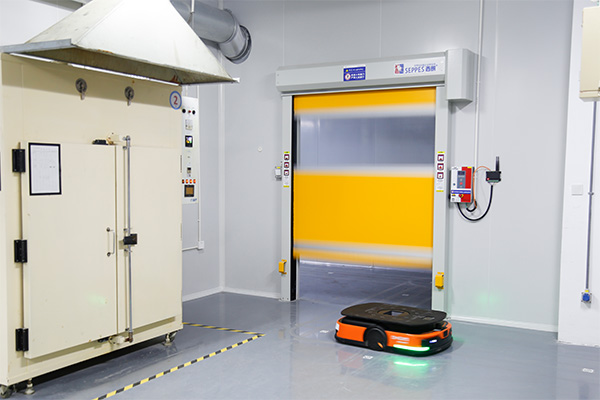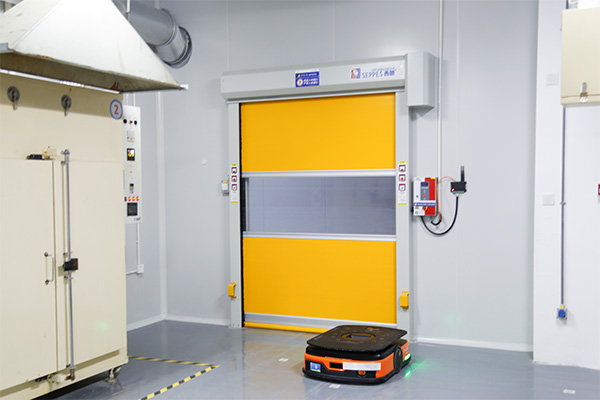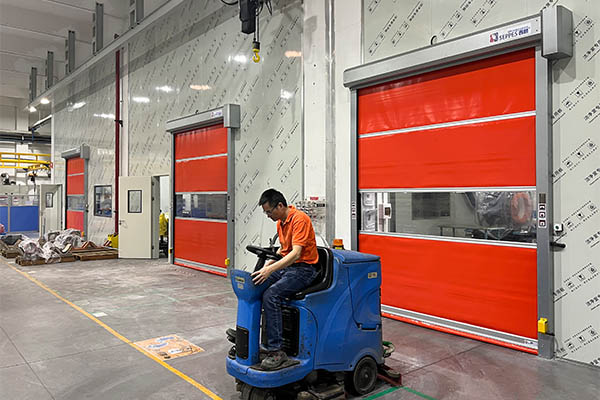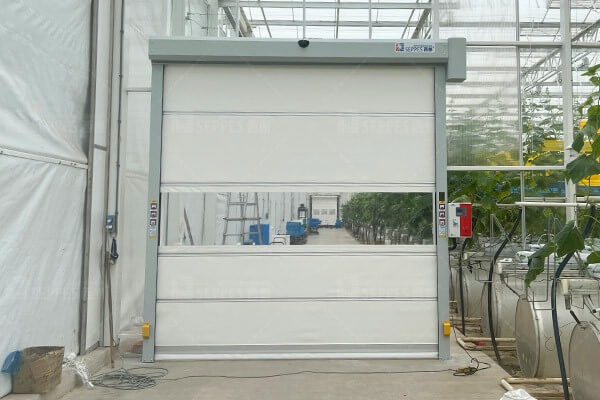
Automated Guided Vehicle Rapid Doors transform warehouse operations by boosting efficiency and safety. You can experience a significant increase in productivity, as seen in a case where a distributor achieved a 35% rise in just six months. These technologies reduce manual labor, enhance worker safety, and optimize space utilization. By integrating AGVs and rapid doors, you streamline workflows and minimize downtime. This synergy not only protects products but also ensures a safer work environment, offering fast returns on investment and cost savings.
Understanding Automated Guided Vehicle Rapid Doors
What are AGVs?
Definition and basic functions
Automated Guided Vehicles (AGVs) are intelligent robotic systems that autonomously navigate warehouse floors. They transport goods and interface with machinery without human intervention. These self-operating robots come in various shapes and sizes, each designed for specific transportation functions. AGVs rely on advanced guidance systems like laser, LiDAR, and magnetic tape to follow programmed routes. This technology streamlines material handling and inventory management, enhancing overall productivity.
Role in modern warehouses
In modern warehouses, AGVs play a crucial role in optimizing operations. They handle tasks such as stock replenishment, picking processes, and transportation. By reducing manual labor, AGVs help lower labor costs and minimize errors in inventory management. Their ability to operate continuously without breaks ensures a constant flow of materials, which boosts efficiency. Integrating AGVs with Warehouse Management Systems (WMS) provides better visibility of material locations and quantities, further enhancing warehouse efficiency.
What are Rapid Doors?
Definition and basic functions
Rapid doors are high-performance doors designed for quick opening and closing. They facilitate the swift movement of goods in and out of storage areas. These doors minimize downtime during loading and unloading processes, contributing to a more streamlined workflow. Rapid doors also improve safety and security by providing quick access while minimizing exposure to external elements.
Role in modern warehouses
In the context of modern warehouses, rapid doors complement AGVs by enhancing operational efficiency. They allow for faster movement of goods, significantly improving order fulfillment times. The use of rapid doors reduces energy loss and contributes to temperature control, making them an energy-efficient choice. By integrating rapid doors with AGVs, you can achieve a seamless flow of materials, reducing bottlenecks and optimizing labor resources.
Benefits of AGVs in Warehouses
Improved Safety
Automated Guided Vehicles (AGVs) significantly enhance safety in warehouse environments. By eliminating human errors, AGVs ensure a more reliable and consistent operation. You can trust AGVs to follow strict safety protocols, reducing the risk of accidents. Unlike human operators, AGVs do not suffer from fatigue or distractions, which often lead to mistakes. This reduction in human error directly contributes to a safer workplace.
Reduction in human error
AGVs operate with precision, minimizing the chances of errors that are common with manual labor. They follow programmed routes and tasks without deviation, ensuring that goods are transported accurately and efficiently. This precision reduces the likelihood of mishaps and damage to products.
Enhanced workplace safety
The use of AGVs in warehouses enhances overall safety by reducing ergonomic issues associated with manual handling. Workers face fewer physical demands, decreasing the risk of injuries. AGVs also improve hygiene by minimizing human contact with goods, which is particularly beneficial in sensitive environments like dairy production facilities.
Space Maximization
AGVs offer remarkable advantages in terms of space utilization. Their compact design and ability to navigate tight spaces allow for more efficient use of warehouse areas. You can optimize your layout to accommodate more inventory without compromising accessibility.
Efficient use of warehouse space
AGVs require less space than traditional equipment like forklifts. Their ability to move through narrow aisles and tight corners maximizes storage capacity. This efficient use of space enables you to store more products and improve inventory management.
Flexibility in layout design
With AGVs, you gain flexibility in designing your warehouse layout. You can easily reconfigure paths and storage areas to adapt to changing needs. This adaptability ensures that your warehouse remains efficient and responsive to business demands.
Productivity Enhancement
AGVs boost productivity by streamlining material handling processes. They operate continuously, ensuring a constant flow of goods and reducing downtime. This capability leads to faster order fulfillment and increased throughput.
Faster material handling
AGVs handle materials swiftly and accurately, reducing the time spent on transportation tasks. Their ability to work around the clock without breaks ensures that operations run smoothly and efficiently.
Continuous operation capabilities
Unlike human workers, AGVs do not require rest periods. They can operate 24/7, maintaining a steady pace of work. This continuous operation capability enhances productivity and allows you to meet high demand without delays.
Error Reduction
Precision in material transport
Automated Guided Vehicles (AGVs) excel in delivering precise material transport. You can rely on AGVs to follow programmed routes with pinpoint accuracy. This precision ensures that goods reach their intended destinations without deviation. Unlike human operators, AGVs eliminate the risk of navigational errors. They use advanced guidance systems like laser and LiDAR to maintain exact paths. This technology guarantees that your materials move efficiently and accurately within the warehouse.
Decreased risk of damage
AGVs significantly reduce the risk of damage to goods during transport. Their automated nature ensures consistent handling, minimizing the chances of mishaps. You benefit from AGVs’ ability to handle materials gently and consistently. This reduces the likelihood of product damage, which is common with manual handling. AGVs follow strict safety protocols, ensuring that goods remain secure throughout the journey. By using AGVs, you protect your inventory and maintain product quality, leading to fewer losses and increased customer satisfaction.
Advantages of Rapid Doors

Speed and Efficiency
Quick opening and closing times
Rapid doors excel in speed, opening and closing swiftly to facilitate the movement of goods. You can rely on these doors to minimize waiting times, which enhances the overall efficiency of your warehouse operations. The quick action of rapid doors ensures that goods move seamlessly between different areas, reducing the time spent on loading and unloading. This efficiency is crucial in maintaining a steady workflow and meeting tight deadlines.
Minimization of downtime
By incorporating rapid doors, you significantly reduce downtime in your warehouse. These doors operate with precision, ensuring that they open and close only when necessary. This minimizes unnecessary delays and keeps your operations running smoothly. You benefit from a more streamlined process, as rapid doors prevent bottlenecks and maintain a constant flow of materials. This reduction in downtime translates to increased productivity and improved order fulfillment rates.
Energy Efficiency
Reduction in energy loss
Rapid doors contribute to energy efficiency by minimizing energy loss. Their quick operation reduces the time that doors remain open, which helps maintain the internal climate of your warehouse. You can expect lower energy costs as rapid doors prevent drafts and temperature fluctuations. This energy-saving feature is particularly beneficial in temperature-sensitive environments, where maintaining consistent conditions is crucial.
Contribution to temperature control
In addition to reducing energy loss, rapid doors play a vital role in temperature control. They help maintain the desired climate within your warehouse, ensuring that goods remain in optimal conditions. You can trust rapid doors to provide a barrier against external elements, which is essential for preserving the quality of temperature-sensitive products. This contribution to temperature control not only protects your inventory but also supports energy-efficient practices.
Workflow Optimization
Streamlined movement of goods
Rapid doors enhance workflow optimization by streamlining the movement of goods. You can achieve a more organized and efficient process as these doors facilitate quick transitions between different areas. The seamless operation of rapid doors ensures that goods move without interruption, reducing the risk of delays. This streamlined movement is essential for maintaining high productivity levels and meeting customer demands promptly.
Improved traffic flow
With rapid doors, you experience improved traffic flow within your warehouse. These doors allow for smooth transitions, preventing congestion and ensuring that materials move efficiently. You benefit from a more organized layout, as rapid doors support the integration of Automated Guided Vehicle Rapid Doors systems. This synergy enhances the overall efficiency of your warehouse, leading to faster order processing and increased throughput.
Integrating Automated Guided Vehicle Rapid Doors

Complementary Technologies
How AGVs and rapid doors work together
Automated Guided Vehicle Rapid Doors create a seamless integration that enhances warehouse operations. You will find that AGVs, with their autonomous navigation, efficiently transport goods across the warehouse. Rapid doors complement this by providing quick access to different areas. This combination ensures that AGVs can move without delay, maintaining a steady flow of materials. The rapid doors open and close swiftly, minimizing waiting times and preventing bottlenecks. This synergy between AGVs and rapid doors optimizes the movement of goods, leading to improved productivity and efficiency.
Synergy in enhancing efficiency
The collaboration between AGVs and rapid doors results in a significant boost in operational efficiency. You can expect a reduction in downtime as rapid doors facilitate the swift transition of goods. This efficiency is crucial in high-throughput environments where speed is essential. The rapid doors’ ability to regulate temperature and control dust further enhances the working conditions within the warehouse. By integrating these technologies, you create a safer and more efficient workspace. This synergy not only improves workflow but also contributes to cost savings by optimizing labor resources.
Implementation Strategies
Best practices for integration
To successfully integrate Automated Guided Vehicle Rapid Doors, you should follow several best practices. First, assess your warehouse layout to ensure it accommodates both AGVs and rapid doors. You need to design pathways that allow AGVs to navigate smoothly while ensuring rapid doors are strategically placed for optimal access. Training your staff on the operation and maintenance of these technologies is essential. Regular maintenance checks will ensure that both AGVs and rapid doors function efficiently. By implementing these practices, you can maximize the benefits of these technologies.
Case studies of successful implementations
Several companies have successfully integrated Automated Guided Vehicle Rapid Doors into their operations. For instance, a leading logistics provider reported a 40% increase in throughput after implementing these technologies. They redesigned their warehouse layout to accommodate AGVs and installed rapid doors at key entry points. This strategic integration reduced loading and unloading times, leading to faster order fulfillment. Another company in the food industry improved temperature control and hygiene by using rapid doors, which complemented their AGVs’ efficient material handling. These case studies demonstrate the transformative potential of integrating AGVs and rapid doors in various industries.
Challenges and Solutions
Potential Challenges
Initial cost and investment
Implementing Automated Guided Vehicle (AGV) systems and rapid doors in your warehouse can require a significant initial investment. The cost of purchasing and installing these technologies might seem daunting. You need to consider not only the price of the equipment but also the expenses related to infrastructure modifications and staff training. This upfront cost can be a barrier for many businesses, especially small to medium-sized enterprises.
Technical integration issues
Integrating AGVs and rapid doors into your existing warehouse operations can present technical challenges. You may encounter compatibility issues with current systems or face difficulties in configuring the new technologies to work seamlessly together. Ensuring that AGVs communicate effectively with rapid doors and other warehouse systems is crucial for optimal performance. Without proper integration, you might experience disruptions in workflow and efficiency.
Solutions and Recommendations
Cost-benefit analysis
Conducting a thorough cost-benefit analysis can help you justify the initial investment in AGVs and rapid doors. By evaluating the long-term savings and efficiency gains, you can make a more informed decision. Consider factors such as reduced labor costs, increased productivity, and improved safety. These benefits often outweigh the initial expenses over time. A detailed analysis will provide you with a clearer picture of the potential return on investment.
Partnering with experienced vendors
Partnering with experienced vendors can ease the integration process of AGVs and rapid doors. These vendors offer valuable expertise and support, ensuring that the technologies are implemented correctly. They can provide comprehensive training for your warehouse staff and operators, helping them interact with and manage the AGV system effectively. Proper training is essential for maximizing the benefits of these technologies and minimizing potential issues.
“In a system with a human-centered design, where workers cooperate with AGVs, it is important to use information about people’s ways of acting,” researchers emphasize. Proper communication between AGVs and humans is crucial for system performance. By working with knowledgeable vendors, you can ensure that your warehouse operations run smoothly and efficiently.
Automated Guided Vehicle Rapid Doors revolutionize warehouse efficiency. You gain improved safety, productivity, and space utilization. These technologies transform operations by reducing manual labor and enhancing workflow. Their integration offers a seamless flow of materials, minimizing downtime and maximizing throughput. As a decision-maker, consider these innovations for future-proofing your warehouse. Embrace the potential of Automated Guided Vehicle Rapid Doors to stay competitive and meet evolving demands. By adopting these advancements, you ensure a modern, efficient, and safe warehouse environment.





















